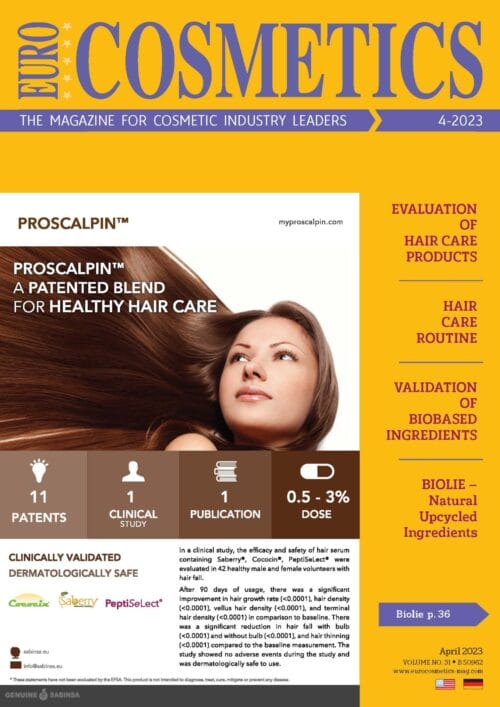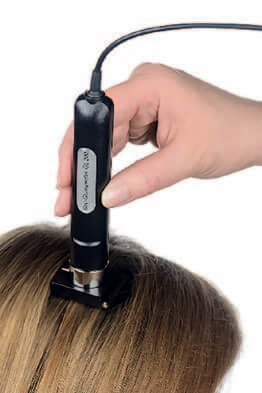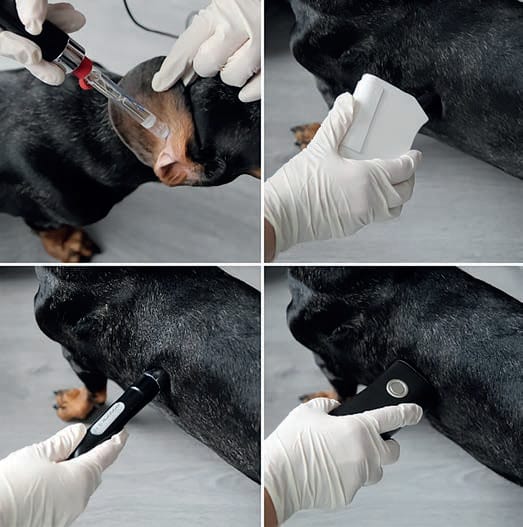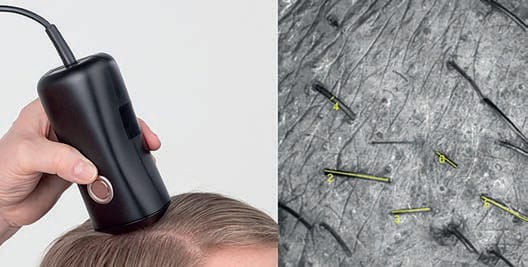By C. Uhl, D. Khazaka, and A. Pouladi

Hair diversity (style, shape, growth pattern or color) is one of the most important features to define us physically.
Therefore, it is no surprise that the market of hair care products with a value of 93.5 billion US $1 (Statistica, September 2020) is one of the most important sectors in the complete area of cosmetic products. Hair care products for women are the most frequently bought and used cosmetic products of all. Shampoos and conditioners are leading the field. For men, hair care is the most important and favored sector of all cosmetics.2
However, there is more to it. Nowadays, social media, most of all Instagram, influences different generations. Besides skin, hair is the characteristic attribute for health, youth and attraction. Hair can even be a communication tool and a political instrument. Just take as an example the men who grow a moustache of their own style every November of a year, the so called Movember, to raise funds for men’s health.2

Plenty of products and treatments are ready to fit the modern hair care market for thin, thick, curly, dry, oily, blonde, coloured, ethnic, young, or old hair. Imagine any claim, the product is already invented. As hair is unique, personalised products flood the hair care market. Respectively, there is an ever-growing number of claims around the various products. Hair care rituals can be complemented with food supplements and treatment devices.3
Tests on hair tresses
In this context, claim-related best practice in vitro biophysical methods, including instrumental methods (mechanical and visual) to describe hair fibre characteristics, have been established:4,5,6
The most widely used instrumental-based mechanical test to measure the efficacy of shampoos, conditioners, masks and other hair care products is the combing forces test on hair tresses as it supports a broad range of claims. Wet and dry combing forces are determined to substantiate claims such as combability, conditioning, detangling or easy-to-comb. Mechanical measurements of hair breakage provoked by continuous combing of hair tresses show how effective hair care products are regarding protection or resistance to hair damage caused by combing. The amount of broken hair fragments is determined to support claims such as anti-split ends or anti-breakage.
Friction tests, where a bar is pulled along a hair tress, are applied to support claims like “smooth and silky performance”.
The tensile properties of hair are depending on its inner structure. Their measurement offers a view into activities lying within. Hair strength is affected by a wide range of influencing factors, so it is often seen as a primary measure of hair damage which can be analysed with the Single Fiber Tensile or Single Fiber Fatigue Test.
Differential Scanning Calorimetry (DSC) is performed to support claims such as heat- and UV protection. By applying heat to the hair, a denaturing effect of keratin will occur. Applying this method, the thermal resistance of hair’s major morphological components can be determined.
Hair consists of 12 to 15 % of water which is one of the most important fibre properties. The water content of hair can be measured through the Hair’s Technical Water Content Test. The main factor contributing to the hair water content is the relative humidity of the surrounding atmosphere. This relationship is described via the hair water adsorption isotherm.
Bending tests support claims like long lasting hold and strength of fixation. There are three different test types depending on the product to be evaluated; such as bending the hold-providing film, remaining hold and flexibility of the hold.
For assessing hair shine/gloss, colour, curl retention and volume, visual tests have become standard in practice. Hair gloss assessment e.g. is mainly performed visually by an expert panel; colour protection and anti-colour fade products or the durability of colour-dyed hair are measured by using a Colorimeter and the volume of a hair tress can be assessed using a silhouette technique followed by image analysis.
Testing hair and scalp in vivo
For the hairless skin, objective testing methods have been known for decades. Some of these “classical methods” have also been used on hair and scalp for quite a while.
Sebum on hair & scalp
The sebum for hair and scalp is produced by the sebaceous glands on the scalp. The sebum gland releases the oil to the hair via a small channel. It is then transported along the hair shaft away from the scalp. The main task of the sebum is to protect the scalp and to keep the hair shiny and supple while preventing it from breaking.
When produced in a high quantity, sebum leads to greasy hair and scalp problems that may cause increased microbial activity and oily dandruff. Especially in urban areas with high pollution, fine dust particles and other pollutants may cling to the oil, making the hair look dull and degrading the hair quality. To remove the oil and pollutants, frequent washing is required which will most notably dry out longer hair. Also, this might just trigger the production of more oil to compensate for the frequent removal –leading to a vicious circle. So, the aim would be to balance the oil production to a moderate level or develop products with lipid-restoring properties.
The Sebumeter® e.g. is not only the worldwide most-used instrument to determine the sebum content of the skin but already in the 1980ies and the early 90ies, work has been presented about the usefulness of this device on hair and scalp.7,8
For optimal reaching the hairy scalp, a special adapter can be useful to measure with the milky foil of the Sebumeter®. After the measurement, the transparency is evaluated photometrically.

Hair colour and gloss are “evergreens” among the claims around hair care
Easy and quick to use Colorimeter and Glossymeter devices that have been used on skin for a long time, are also suitable to support booming claims like brightening, luminosity, shine, colour intensity/lasting for hair. With special small measuring heads the scalp can be evaluated through the hair, e.g. increased erythema due to irritation.



Hydration
Hydration on hair is more difficult to measure than on skin. One method that has been used to determine the moisture content of hair, is the measurement of induced chemoluminescence, a method that requires a huge financial and spatial expenditure, or the use of Differential Scanning Calorimetry (DSC) as described above. However, products applied on the hair and scalp cannot really influence the moisture content in the hair. Normal, healthy hair is designed to prevent substances from entering the inside. The common concern of the consumers about dehydrated hair9 and the respective popular product claims mean something else. It is more about the feel of the hair, the shine and the elasticity/bending properties. The hair looks less straw-like and more vital.
Product Safety
The pH-value on hair and scalp plays an important role in the efficacy testing of hair care. Claims like “pH-neutral” or “sensitive” are easy to support by pH-measurements.

The barrier function of the scalp is the key parameter in the safety and efficacy evaluation of products applied on the head. Since the ban of animal testing in the development of cosmetic products, TEWL measurements have to take place in vivo on human subjects and in vitro on cultured cell tissue. The open chamber measurement of the Tewameter® is the worldwide most-used method for the assessment of transepidermal water loss (TEWL). The Tewameter® Nano probe has been developed to especially measure the scalp. With its small measurement surface of only 2 mm in diameter, the scalp can be easily reached through the hair. TEWL measurements are also used as indirect measurements of the water content on the scalp.

Claims on health and shine are also used on animal hair especially in regards to food and food supplements. The same way as human hair and scalp, animal skin and fur can be tested with these techniques.

Imaging
Following the tendency in evaluating skin care efficacy and its claim support, also in hair care development, more and more methods are based on image analysis.
The evaluation of the hair length can be used for different claims. In hair care and for food/food supplements, hair length assessment can substantiate hair growth claims. Also, in testing the quality of shaving, this measurement will be useful. Thickness measurement of the single hair is used to show the volumizing effect of products.
Special UV-based cameras such as the Visioscan® offer high resolution, non-glossy images of hair and scalp. Other cameras with parallel- and cross-polarized light show scalp and hair images from different angles.

Visioscan® VC 20plus
Other methods such as transmitted light microscopy, scanning electron microscopy (SEM) but also high resolution-cameras with magnification objective can show structural hair fibre damages and substantiate hair repair claims.
Dandruff
The same way as skin does, the scalp will constantly shed small dandruff flakes from its surface. This is a normal process making room for new cells growing from the base of the epidermis. Usually, these minuscule and more or less imperceptible flakes will be removed by washing and combing the hair. However, almost 50% of the world population show plainly visible flakes at one time or another, a problem described as dandruff.10 In general, dandruff causes more social and psychological problems than medical ones, effecting self-esteem and confidence.11
Dandruff is difficult to define because it can manifest in different conditions and blurs with seborrhoeic dermatitis and other scaly skin problems such as atopic dermatitis and psoriasis.12 It is often linked to the colonization of the scalp by Malassezia, a fungal microorganism. Also, seborrhoeic conditions, allergies or dehydration of the scalp may result in dandruff. Additional external triggers have been identified, such as sun exposure13 or treatment with unsuitable products.
While the scalp condition can be assessed by probes such as TEWL measurement and sebum measurement directly on the scalp and skin surface moisture on the forehead close to the hairline, the extent of dandruff can be assessed either by expert rating, or, for more objective testing by imaging methods using the DandruffMeter. Dandruff flakes are sampled by the application of a defined combing procedure. The collected flakes will be distributed in a wide petri dish onto a dark background material that is then inserted into the DandruffMeter for analysis. Inside the device, circularly arranged LEDs will illuminate this sample homogeneously and in a standardized way. Straight above the illuminated sample, a high-resolution camera will take a picture. Dandruff will shine bright white against the dark background and can be analyzed and categorized in the device software for the amount and sizes of the dandruff accretions. Application of an anti-dandruff shampoo should shift the distribution from larger-sized categories to smaller-sized dandruff flakes.


Testing methods for hair loss
Another wide-spread concern is hair loss. The causes for alopecia are attributed to numerous combined influences ranging from genetic predisposition, increased dehydrotestosterone production, mineral and vitamin deficiency, stress, toxins, colonization with microorganisms to the way that the head is generally held as well as facial expression which are supposedly influencing muscle tension along the head.
Different to other mammals that shed their fur seasonably, human hair undergoes unsynchronized growth cycles.13 This irregular pattern is characterized by hair in different growth stages at the same time, ideally 90% anagen (growth phase), 1–2% catagen (regression phase) and 8–9% telogen (resting phase)14. In androgenetic hair loss, the anagen phase is shortened and the anagen-telogen rate may shift from 6:1 to 2:1.13 The changes from anagen to catagen to telogen and the ratio of the different hair growth stages can be assessed by trichography, either by microscopic determination of the hair roots of torn-out hair or by devices measuring hair growth within a certain time span after shaving like the Trichoscan® device.
Often, at the same time the single hair is thinning.14 The combination of decreased hair regrowth and thinner hair leads to the overall impression of baldness. Hair thinning can be assessed by special dermatoscopes (trichoscopy) or by using the Visioscan camera and objectively measuring the thicknesses of single hair.
Other sources also point to the scalp microbiome being involved in hair loss by promoting inflammation.15 Especially two bacteria and their ratio play an important role: if the balance between cutibacterium acnes (syn. propionibacterium acnes) and staphylococcus aureus shifts towards the latter, less inflammation will occur and hair loss is limited. The activity of the cutibacterium acnes can be made visible and calculated by using special UV-wavelengths that will cause an autofluorescence of the porphyrins produced by the acne bacteria. The Visiopor® is a handy and efficient camera emitting UV-light of this specific wavelength onto a small area of the skin surface (6.4 mm x 8 mm) and recording the occurring fluorescence. The amount, area and intensity of these fluorescent spots can then be automatically calculated and compared over the treatment time.

pictures from the scalp
Besides optical analysis, also the measurement of scalp stiffness can give interesting insights. It could be observed that balding men and women tend to have chronically tighter scalps than those without hair loss. Studies have been clearly identifying mechanical stress on the scalp as an active factor in androgenetic alopecia.16 Measurement of the rigidity (stiffness) of the scalp could therefore give additional information on the efficacy of tension-relieving methods. The Scalp Indentometer with a 1 mm diameter indenter can be used to show improvement in scalp rigidity.
Microcirculation that has also been found to be involved in hair loss can be easily determined by measuring the scalp temperature.17
Completing the circle
Is skin care the new hair care? Claims known in skin care for quite some time as anti-aging, pollution defense, exfoliating scrub, vitamin-infused, collagen boosting become increasingly common in the hair care market as it continues to diversify beyond the standard shampoo, conditioner and styling aids categories.18 Or is hair care the new skin care?19 Our hair is as individual as we are. The skin of the scalp is more permeable than the skin of our face. Personalized trends already known for a long time in skin care, are also gaining ground in hair care.
The same measurement methods used in the development and efficacy testing of hair care can be used in simplified forms at the various points of sale to lead the consumer through the jungle of products and find the individual suitable hair care range.
References
- https://de.statista.com/themen/2061/haarpflege/
- Maria Valéria Robles VelascoI et al: Hair fiber characteristics and methods to evaluate hair physical and mechanical properties, Braz. J. Pharm. Sci. vol.45 no. 1 Sao Paulo Jan./Mar. 2009: https://www.scielo.br/ scielo.php?script=sci_arttext&pid=S1984-82502009000100019
- https://de.movember.com/
- Nicole Braun, Ulrike Heinrich: What Can Complex Dietary Supplements Do for Hair Loss and How Can It Be Validly Measured – A Review, July 2020: https://www.mdpi.com/ 2076-417/10/14/4996/htm
- Trefor A. Evans, Ph.D: Testing Tactics in Hair: Equipment – A Buyers Guide, September 2020: https://www. cosmeticsandtoiletries.com/testing/equipmentevaluation/Testing-Tactics-in-Hair-EquipmentA-Buyers-Guide-572275781.html
- M. Brand et al: Substantiating Claims for Hair Care Products: https://www.sofw.com/de/sofw-journal/archiv/archiv2/176-sofw-journal-6-2016
- Beauty Tomorrow, March 2015: The chemical properties of hair: https://beautytmr.medium.com/the-chemical-properties-of-hair-955985908d05
- H.I. Maibach, E. Patrick: Session VI: Hair, sebaceous glands and nails. 7th International Symposium of Bioengineering and the Skin,1988.
- S. La Mendola, F. Rinaldi, M.C. Salvadori, F. Clemente: Competence and satisfaction: a study of the hair and shampoo of 1,000 users of a trichology service. 18th International IFSCC Congress, Venice, October 1994.
- Top 10 global consumer concerns in haircare (2015) – https://frattempo.co.uk/top-10-global-consumer-concerns-in-haircare
- B. Sommer, D.P. Overy, & R.G. Kerr: Identification and characterization of lipases from Malassezia restricta, a causative agent of dandruff. FEMS Yeast Res 15 (2015).
- R. Grimalt.: A Practical Guide to Scalp Disorders. Journal of Investigative Dermatology Symposium Proceedings. 12 (2): 10–14., December 2007, doi:10.1038/sj.jidsymp.5650048. PMID 18004290
- S. Ranganathan, T. Mukhopadhyay: Dandruff: The Most Commercially Exploited Skin Disease, Indian J. Dermatology, 2010, April-June; 55 (2): 130-134
- M. S. Orasan et al.: Hair loss and regeneration performed on animal models, Clujul Med. 2016; 89(3): 327–334, July, 2016
- V. A. Randall: Androgens are the main regulator of human hair growth. In: Camacho F, Randall VA, Price V, editors. Hair and its Disorders: Biology, Pathology and Management. London: Martin Dunitz; 2000. pp. 121–136.
- R.S. English, jr.: A hypothetical pathogenesis model for androgenic alopecia: clarifying the dihydrotestosterone paradox and rate-limiting recovery factors, ScienceDirect, Medical Hypotheses 111 (2018): 73-81.
- A. Gerkowicz: Videocapillaroscopic Alterations in Alopecia Areata, BioMed Research International, Volume 2013, Article ID 160203
- Global Cosmetic Industry Magazine online, May 2020 – Is Skin Care the New Hair Care?
- Marina Jagemann The Online Magazin for Anti-Aging and Aesthetic Medicine: https://www.marinajagemann.com/mehr-haare-bitte/



